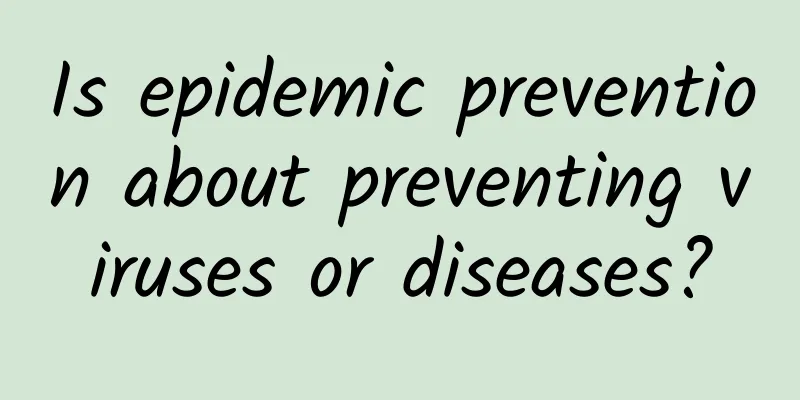Is epidemic prevention about preventing viruses or diseases?

|
What is poison and what is disease? Virus is a virus, and disease is a viral disease caused by virus infecting humans. 【"Other" virus】 Pangu created the world by breaking the original universe that was "shaped like an egg" (egg refers to an egg), but the birth of life requires the formation of a "egg" - a primitive cell structure wrapped by a plasma membrane. The birth of the plasma membrane made the primitive life a self-contained system, creating a distinction between "I" and "non-I". About 3.5 billion years ago, there was such a type of cell that reproduced to produce a new individual "you", and evolved to produce a new species "him", so "everyone" was born. This type of cell is "LUCA" (Last Universal Common Ancestor, LUCA), the common ancestor of all cellular organisms. Luca's descendants can be arranged on a unified evolutionary tree based on evolutionary relationships. Figure 1: “We were one family 3.5 billion years ago.” Common ancestor of cellular organisms and their evolution | Photo provided by the author Viruses are not on this tree. According to the material basis, structure and sequence information of the viral genome, viruses have multiple origins and do not have a single common ancestor (see "The spread is better than SARS, do we need to worry about the mutation of the new coronavirus"). The genetic information between viruses and cellular organisms is very different, and no gene is shared by all viruses, so there is no unified genealogy. Therefore, the evolutionary tree of viruses looks like a bush outside the giant tree of life evolution. Viruses are also on this tree. Viruses are a type of obligate intracellular parasitic microorganisms without cell structure. Viruses that leave the cell are like biological macromolecules, and their life characteristics all depend on being carried out inside the host cell. The life characteristics of viruses are also limited to replication and evolution. There is no metabolism, no homeostasis, no growth, and no response to the environment... In short, they lack most of the characteristics shared by life. Therefore, some scholars do not think that viruses are living organisms (organisms), but simply call them biological entities. The reason why viruses are also on this tree is that almost all cellular organisms can be infected by viruses. Chickens lay eggs for us, cows produce milk for us, plants provide us with vegetables, fruits and food, and can also produce oxygen. What do viruses do for us? The self-centered way of thinking is indeed questionable. "Heaven and earth are not benevolent, and treat all things as straw dogs." All life, without exception, plays the same game: survival. "Survival of the fittest." In order to survive, the biological world has evolved a variety of ways of survival, armor, wings, claws... and even wisdom. As individuals, our worries and joys, our lifelong pursuit of the meaning of life, on the "road" of life, may only be abstracted into the transmission of "incense" - we are the carriers of genetic information existence and reproduction. And the virus has become the most "pure" life form. It almost does not need to prepare everything by itself. It parasitizes in cells and lets others help it "live" and "survive" - the virus is an "extremely selfish" genetic information replication device. Viral disease is a "side effect" produced by the process of virus infecting the host and replicating itself. Viruses are an important class of pathogens. More than 70% of human infectious diseases are caused by viruses. From the perspective of epidemic prevention, viral diseases are the main reason why people pay attention to viruses. [Viruses and viral diseases should be viewed separately] What are the names of the viruses and diseases involved in the COVID-19 outbreak? This is a very basic question, but few people can answer it correctly. The new disease that emerged at the end of 2019 is currently named "Coronavirus disease 2019 (COVID-19), which is generally called "COVID-19" in my country (strictly speaking, the scope of COVID-19 is larger than "COVID-19", including other mild and moderate diseases besides pneumonia, and pneumonia is the main manifestation of severe COVID-19); and the virus that causes COVID-19 is named "Severe acute respiratory syndrome coronavirus 2" (Severe acute respiratory syndrome coronavirus 2, SARS-CoV-2). COVID-19 is a viral disease caused by SARS-CoV-2, which is the pathogen that causes COVID-19. A large number of asymptomatic infections and mild patients tell us that infection with SARS-CoV-2 does not necessarily lead to COVID-19 (morbidity), let alone "new coronary pneumonia" (severe illness rate) or death (case fatality rate). With the evolution of SARS-CoV-2 itself and the development of natural immunity or vaccination in the population, the severe illness rate and mortality rate are still continuing to decline. Therefore, whether a virus causes disease after infecting a person, and the severity of the disease are not fixed. The virus is only one of the factors that determine the severity of the consequences of a viral disease. Other factors include the infected person's own condition, medical conditions, etc. Distinguishing between viruses and viral diseases can help us correct many misconceptions. For example, it is impossible for us humans to live in peace with COVID-19 or "new coronavirus pneumonia" because the human body either recovers from acute viral infections or is killed by the disease, and we need to reduce the occurrence of severe illness; and eliminating the SARS-CoV-2 virus is also a very difficult task because the new SARS-CoV-2 is more contagious and secretive, especially in the presence of huge viral reservoirs (the virus is still prevalent abroad). For another example, the key point of the protective effect of vaccines is to "protect the vaccine recipients from disease, especially severe illness or death." In terms of infection and transmission, vaccines will at least provide some protection, but the protective effect is not as great as the role in preventing severe illness and death. Therefore, it is wrong to assert that vaccines are ineffective because they believe that vaccines cannot greatly reduce the risk of the vaccine recipient being infected by the virus again. Is it sophistry to distinguish between viruses and viral diseases to talk about epidemic prevention? First of all, we must be clear that the purpose of epidemic prevention is to prevent diseases. Since pathogens are the cause of infectious diseases (etiology), we can prevent infectious diseases by eliminating pathogens or sources of infection, cutting off the transmission route, or protecting susceptible populations. Preventing diseases is the goal, and eliminating pathogens is one of the means of preventing diseases , not the only one. Distinguishing between viruses and viral diseases will help us find the most appropriate measures to prevent and control viral diseases. Virus-Host Relationship With limited resources, we can only solve the most urgent or important things, and the attention paid to viruses and viral diseases is no exception. There are tens of thousands of viruses on the earth, and only those that cause serious viral diseases in humans will receive more attention. We need to take targeted and corresponding epidemic prevention measures based on the characteristics of virus transmission and pathogenicity. Next, we will understand the complex diversity of the relationship between humans and viruses from multiple dimensions. From the perspective of host range Viruses infect other organisms with a high degree of specificity. First, viruses can only complete a complete replication cycle in a specific host. For example, SARS-CoV-2 can only replicate in mammals, but not in insects or plants, so it will not infect insects or plants. Second, viruses can only infect specific cell types. Although viruses are small, they are widely distributed in nature and exist in huge numbers. Take marine viruses as an example. There are an average of 10 million viruses in 1 ml of seawater. In terms of quantity, this is an order of magnitude more than the prokaryotes (bacteria and archaea) in the ocean. In terms of total mass, viruses are the second largest marine biological group after prokaryotes in terms of total biomass [1] . Although marine viruses have great ecological and academic research value, they are almost irrelevant at the epidemic prevention level because most marine viruses are bacteriophages that only infect prokaryotes, not plants or animals. What usually attracts people's attention are viruses that can infect humans, livestock and crops, which are the contents of basic medicine, animal medicine and plant disease resistance research. There are a large number of infectious diseases that can infect both humans and animals at the same time, called zoonoses . In fact, more than 70% of emerging infectious diseases are zoonoses, which are transmitted from animals to humans. This process is called zoonotic spillover. During spillover, viruses must overcome many obstacles to achieve cross-species transmission. In addition to breaking through geographical barriers, mutation is an important way for viruses to spread from the original host to the new host. After the virus mutates, it acquires the ability to infect a new host, a process called host leaping. Pathogens enter new hosts and often cause more severe diseases than those caused in the original host. Therefore, monitoring animal pathogens is an important task in preventing and controlling infectious diseases. The SARS-CoV-2 pandemic shows that humans urgently need to better understand the mechanisms of zoonotic spillover. In 2004, the Wildlife Conservation Society first proposed the concept of "One World, One Health", suggesting that we should enhance our understanding of the links between the health of humans, domestic animals and wild animals. "One Health" is a new strategy of cross-disciplinary, cross-regional collaboration and communication involving all aspects of human, animal and environmental health care, dedicated to jointly promoting the health of humans and animals and maintaining and improving the ecological environment [2] . In fact, it is very difficult to eliminate animal virus reservoirs for human diseases because animals, especially wild animals, are difficult to manage. Despite this, scientists have also done a lot of work, the most notable of which is the monitoring of migratory birds carrying avian influenza viruses and the study of bats carrying viruses. It is currently believed that bats are the source of the new coronavirus epidemic. The types of cells that viruses can infect are also specific, which determines the virus's infection route and the organs that can be affected by the disease. The virus starts from specific cell types in the respiratory tract, digestive tract, urogenital tract and skin lesions, enters the human body, and then spreads between cells or is transported to other tissues and organs in the body through blood. For example, viruses that can infect respiratory cells can be transmitted through droplets, aerosols or air. Furthermore, viruses that can only infect upper respiratory tract mucosal cells can cause upper respiratory tract infections, that is, common colds. If they can also infect lower respiratory tract or lung cells, they can cause pneumonia. Different ways of virus transmission also bring different difficulties to epidemic prevention. Relatively speaking, airborne pathogens have a higher transmission efficiency and are more likely to cause large-scale epidemics. 【From the perspective of popularity】 The spread of viral diseases has certain temporal and spatial characteristics. Historically, the spread of viruses has the characteristics of the times. In the early urbanization process, people gathered and public health conditions deteriorated, creating conditions for respiratory transmission (influenza), digestive transmission (poliomyelitis, hepatitis A), and vector transmission (urban rat infestation, fleas and other external parasites). In the Age of Exploration, infectious diseases could spread across the ocean, causing great harm to indigenous peoples. As sanitary conditions gradually improved with economic development, the spread of a large number of public health-related infectious diseases was greatly curbed. However, the new era has also created new problems: environmental damage causes new and recurrent viral diseases, frequent international exchanges accelerate the spread of infectious diseases, AIDS continues to rage, and drug-resistant strains appear... From a short-term timeline, viral transmission is seasonal, which is related to the stability of the virus itself in the environment, the migration of virus-carrying animals, the life cycle of insect vectors, and the seasonality of human activities. Figure 4: The types of viral diseases that threaten human health vary greatly in different eras. In addition, the prevalence of common viral diseases is seasonal. Spatially, the epidemic of viral diseases has regional characteristics. Most viral diseases are prevalent in certain regions, and a few can cause transnational epidemics on a global scale. The regional limitations of epidemics depend on the pathogenicity and transmission ability of the pathogen, the transportation links between the origin and the surrounding areas, geographical barriers, the ecological distribution of natural virus reservoirs or insect vectors, etc. As the boundaries between humans and nature become increasingly blurred, the climate and environment change dramatically, and international exchanges and transportation of humans or animals become frequent, emerging and recurrent infectious diseases can be more easily transmitted internationally. For the same virus, as the evolution time increases, the virus strains prevalent within the region can produce more specific mutations and form regional-specific epidemic strains. The spatiotemporal specificity of virus transmission and the current epidemic status are the result of long-term interactions between humans and viruses . In the short term, if the impact of epidemic prevention measures is not considered, the epidemic ability of the virus mainly depends on its basic reproduction number R0. In the long term, the resistance of human immune function and the implementation of strong epidemic prevention measures can often greatly reduce the actual R0 value of highly pathogenic viruses and control highly pathogenic viruses-especially after the invention of vaccines. At the same time, viruses with poor pathogenicity may be ignored by humans, but can spread widely and for a long time in the population. Judging from the actual infection rate of viruses in the population, most cases of virus infection (such as rabies) are relatively rare, some viruses may be pandemic in a short period of time (such as seasonality), and some viruses (such as herpes viruses) are particularly "successful". Among them, the high infection rate is most prominent among herpes viruses. Herpes simplex virus type 1 HSV-1 infects about 3.7 billion people, sexually transmitted virus herpes simplex virus type 2 HSV-2 infects about 846 million people, varicella-zoster virus VZV causes more than 100 million people to become ill each year, and Epstein-Barr virus and human cytomegalovirus infect more than 90% of humans. But these viruses generally do not cause serious harm to humans. (See "Once infected, lifelong recurrence, the most difficult virus in history has conquered 90% of the world's population. If you find it during sex, you must stop it in time丨Virus Super Topic") Another type of virus has changed from an enemy of mankind to a "relative". Endogenous retroviruses (ERVs) are endogenous viral elements present in the human genome. They are generally believed to be residual viral sequences that remain after infecting human germ cells. ERVs account for 5-8% of the length of the human genome, but don’t worry, these viral sequences are generally harmless in the human body. Some studies have also found that they play a positive role in the development of the placenta [5] . References [1] https://aoc.ouc.edu.cn/2021/0325/c15171a316349/pagem.htm [2] https://zh.wikipedia.org/zh-cn/%E5%90%8C%E4%B8%80%E5%81%A5%E5%BA%B7 [3] Su, S., Wong, G., Shi, W., Liu, J., Lai, ACK, Zhou, J., Liu, W., Bi, Y., and Gao, GF (2016). Epidemiology, Genetic Recombination, and Pathogenesis of Coronaviruses. Trends Microbiol. 24, 490–502. [4] https://apps.who.int/iris/handle/10665/206560 [5] https://en.wikipedia.org/wiki/Endogenous_retrovirus#Role_in_genomic_evolution |
>>: [First Aid Tips] Issue 30 - What should you pay attention to after wound suture?
Recommend
Picture of red rash in postpartum women
During the confinement period, if red bumps and i...
What should girls do if they have long nose hair?
Some girls have the problem of long nose hairs, s...
What causes female urethritis?
Gynecological diseases are very common diseases. ...
What is the shape of a pregnant belly?
In daily life, some elderly people or women, afte...
Canalys: Global smartphone shipments to reach 1.22 billion units in 2024, up 7% year-on-year
Market research firm Canalys released data on glo...
If you have pets at home, be alert to tinea capitis!
Author: Li Ruoyu, Chief Physician, Peking Univers...
How can women lose belly fat more effectively?
For today's female friends, figure and appear...
Does laser hair removal affect menstruation?
As people pay more attention to their appearance,...
Why does dysmenorrhea only hurt on the first day?
Generally speaking, the pain on the first day of ...
What is the best medicine for pelvic inflammatory disease?
Everyone should know that the female urinary syst...
What are the symptoms on the day of the second child's birth?
With the opening of the second-child policy in my...
Diagnosis and treatment of vascular dementia
Diagnostic criteria for vascular dementia Vascula...
A woman dreams of stepping on shit
Shit is a kind of feces, a substance that everyon...
Why do I feel pain in my lower abdomen on the right side?
Many women experience some physical discomfort be...
When is the best time to do B-ultrasound to monitor ovulation?
When people are preparing for pregnancy, they wil...









